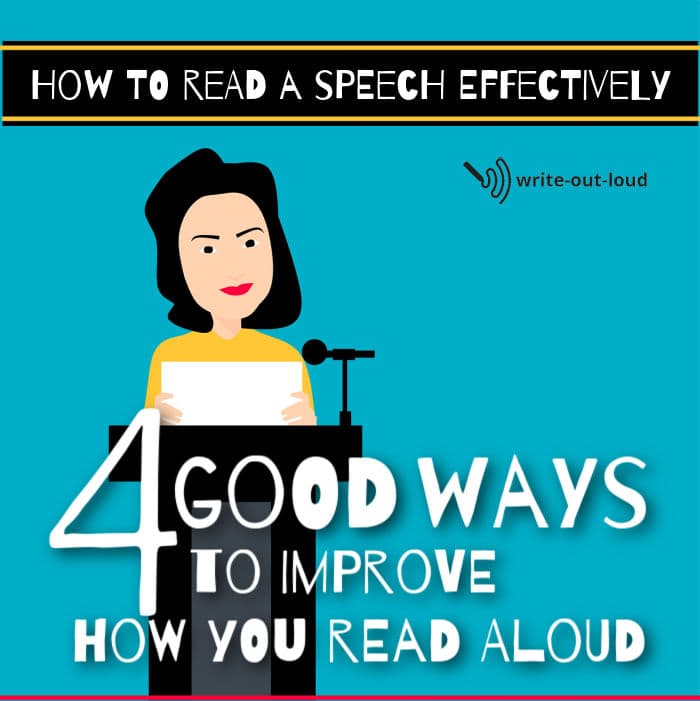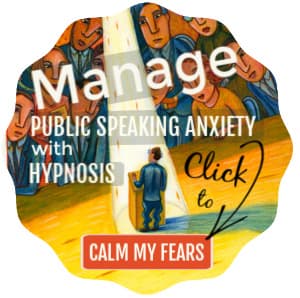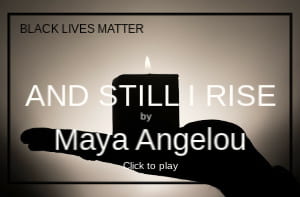- HOME ›
- Speech delivery ›
- How to read a speech effectively
How to read a speech effectively
4 ways to improve how you read out loud
By: Susan Dugdale
Sometimes you just HAVE to read a speech.
I know there's a rule that says a speech should never, ever be read. I don’t know where it’s written. However I’ve heard it repeated frequently enough.
Certainly you’ll not see a person on a TED stage using a teleprompter to deliver their speech.
Chris Anderson, TED's leader and founder is quite clear.
”Don’t read it, and don’t use a teleprompter. It’s usually just too distancing—people will know you’re reading. And as soon as they sense it, the way they receive your talk will shift. Suddenly your intimate connection evaporates, and everything feels a lot more formal. We generally outlaw reading approaches of any kind at TED...” Harvard Business Review – How to give a killer presentation - Lessons from TED by Chris Anderson (2013)
And when I was a member of the international public speaking organization Toastmasters, I discovered they actively discouraged it too for similar reasons.
What's on this page:
- 4 occasions when it's ok to read your speech
- 4 ways to improve your reading aloud skills
- how to practice reading aloud - 5 key aspects of good vocal delivery and the 'see-stop-say' technique
- how to format and mark up your script
- how to use a lectern
- practicing with your script
- Sources of resources for reading aloud practice
- Examples of great public speakers who read their speeches

Occasions when it's OK to read your speech
However sometimes you just have to read your speech.
-
Maybe
it's because you simply didn't have enough time to practice it
thoroughly. (For instance, a polished TED Talk can take 6 months from
preparation of the basic outline to
presentation.)
-
Perhaps
it's because the subject matter is both vital and complicated. Lives depend on it. People are going to pore over every
word. It must be right. You can't afford to slip up presenting it. Like outlining varying safety procedures.
-
Maybe
it’s because the occasion is very emotional (eg. a wedding or a
funeral) and you want the safety of a full speech script to ensure
you stay on track.
- Or perhaps that's what you've been instructed to do. It’s a prepared speech of some sort like a campaign speech or an official corporate statement, and must be read exactly as written.
In situations like these how can a speaker maintain energy and audience connection while reading?
Speeches read poorly are hard to listen to
What
frequently happens when someone reads from a manuscript is not engaging. The speaker is head down looking
at the words and the delivery is flat and stilted. Even if the
content is really interesting it rapidly becomes a challenge to
maintain focus and listen.
4 ways to improve reading aloud skills
1. Practice reading aloud!
Reading aloud well is a skill and like all skills you can acquire it with consistent practice.
I've highlighted two essential elements you'll want to focus on to become competent. These are 5 aspects of good vocal delivery, and the See-Stop-Say technique for ensuring you establish and maintain a connection with your audience while reading.
For both you’ll need a variety of texts, extracts from; non-fiction: newspaper articles, magazine reports, academic papers, famous speeches, and fiction: children's stories, a short story, a poem or an extract from a novel, to work with.
The pieces need to be long enough to practice shaping your delivery to fit the material, the audience and your purpose.* About two minutes worth is generally enough.
Recording yourself will help you identify what you've done well and where you need to focus extra effort.
*Different text types, different audiences and different purposes require you to read differently. Eg. As a professional you wouldn't read an extract from an academic paper to your colleagues at a conference as if it were a piece from a Dr Seuss children's story, even though it might be amusing!☺
5 key aspects of good vocal delivery
Here are five key aspects of good vocal delivery to listen out for when you play back your recording:
-
Are
you stressing or emphasizing the key words?
-
Are
you letting the text's punctuation dictate the phrasing or flow?
For instance, a comma indicates a brief pause. A period or full stop, indicates a longer one. How you deal with pauses, where you put them, and how long you make them affects the phrasing or flow of your speech, which in turn affects how well your audience receives it. (For more on this please see how to use the power of silence in speech: tips for using pauses.)
-
Are
you using appropriate tonal, pitch, volume and rate variations for
the text, as well as the audience? (Too emotional or too bland? Too high or too low? Too loud or too soft? Too fast or too slow?)
-
Is
your enunciation and pronunciation clear and accurate? (They are
different. You can clearly enunciate a word while incorrectly
pronouncing it. E.g., ‘expresso’ v ‘espresso’ or ‘upmost’
v ‘utmost’.) For practice try these tongue twisters.
- Is it what you hear yourself doing congruent with the purpose of the piece? Does it sound right? (E.g. If it's supposed to persuade, does your reading do that?)
Practice the 'see-stop-say' technique
This is a three part method for reading aloud from a manuscript Ronald Reagan first learned as an actor, and then used for his campaign and presidential speeches.
- See - memorize a complete phrase
- Stop - make eye contact with the audience
- Say - deliver the phrase
And now return to the beginning and repeat the sequence as many times as needed. Once you've mastered this technique the awkward head-down-reading, lack-of-eye-contact-with-your-audience problem will have vanished.
For more please see public speaking coach Maria Guida’s excellent article outlining how to learn it step by step: The Ronald Reagan Technique: How to Sound Natural While Reading Prepared Text
2. How to format and mark up your script
Use these tips to format the text on the page for printing to make it easy to read at a glance.
- Use a plain font: Arial or Verdana
- Increase the font size to one you can read without strain. For me that's 20. You need it to be big enough to be read at a glance because you do not want to have to stop to pick up the script to find out what you should be saying.
- Use black ink. The contrast of black ink on white paper makes it easier to read.
- Double space your lines. It will help you return to right place after you've taken a moment to talk directly to the audience.
- Make the borders of the page larger than usual. This centralizes the text on the page. The lines are now shorter and your eyes do not have so far to sweep from one side of the page to the other.
- Number all your pages in the top right corner.
- Print it out single sided.
Marking up your script
Use these tips to mark up your script. The marks are reminders, a bit like the driving instruction signs we have on roads that tell us where to slow down, where to be extra vigilant, and so on.
As you practice you'll become aware of what specific reminders you need to ensure you read as well as you can, and where you need to mark them on your script.
Devise your own marks (short hand code) and use them consistently so that you'll recognize it and know immediately what they're reminding you to do.
For example, slow down could be a line under the words you want to say slowly like this: slow down.
Words you want to stress may have a streak of yellow highlight through them.
Words requiring careful precise pronunciation may be in italics.
A pause for dramatic effect or to allow the audience time to take something in could be shown as a slash highlighted with pink like this: /
A breath might be a symbol like this: ^ and a reminder to check in with the audience to see how they're receiving what you're giving them could be CHECK written in the margin.
3. Use a lectern for your script
Rather
than trying to hold the manuscript while you read it, put it on a lectern.
This eliminates the temptation to mask your face with it and, to rattle its pages. It also leaves you free to gesture.
Make
sure you have the lectern placed a little to one side to avoid creating a
visual barrier between yourself and the audience.
Also check that it's the right height before you begin. You need to be able to comfortably read your script without bending too far down because it's too low for you.
Practice using it. Place your script slightly to the right of the middle. As you finish a page, turn it over face down, and put it on your left. That way you will always have the right page in front of you.
4. Practice with the script
If it’s at all possible, make time to run through the script aloud. If it contains surprises, you'll want to find them before you share them with your audience.
Practice will also give you a chance to gauge timing, sort out the pronunciation of any unfamiliar words, get a handle on the phrasing and vocal variety needs.
Even if you've written the speech yourself, please don't assume it will be fine out loud. It seldom works like that. How we write for the page is very different from writing oral language; words intended to be heard rather than read.*
Say the text over out loud as many times as you can. Reading silently to yourself is not enough.
A 'cold' reading, one without any practice, or without seeing the script before it is handed to you, is very hard to pull off, even for someone accustomed to reading aloud. It’s to be avoided, where ever possible.
Getting started with reading aloud well
Here's a source of Read-Alouds From The New York Times first published in 2010. It was so popular it's been updated since. You'll find all sorts of different types of fascinating material to practice with: the kind that should be marked with a cautionary warning: Time Sink Ahead! Be prepared to lose hours at a stretch.
Here on write-out-loud.com you'll find help with some of the specific skills you need to read well aloud: vocal variety, using pauses, and speech rate.
*For more about writing oral language. You'll find an infographic covering the characteristics of oral language here: how to write a speech.
Great public speakers who read their speeches
And if you do read your speech, and you do it well, know you’re in good company.
Many of the world’s greatest public speakers have read their speeches: Barack Obama, Ronald Reagan, Franklin Roosevelt, and Winston Churchill. For more: lessons from 15 great orators.
Lastly, do make time to watch at least the stunning reading of Sojourner Truth's 1851 speech 'Ain't I a woman?' by writer Alice Walker from this collection of: History’s Most Powerful Speeches Given By Women. It's a masterclass!
Return to: speech delivery




